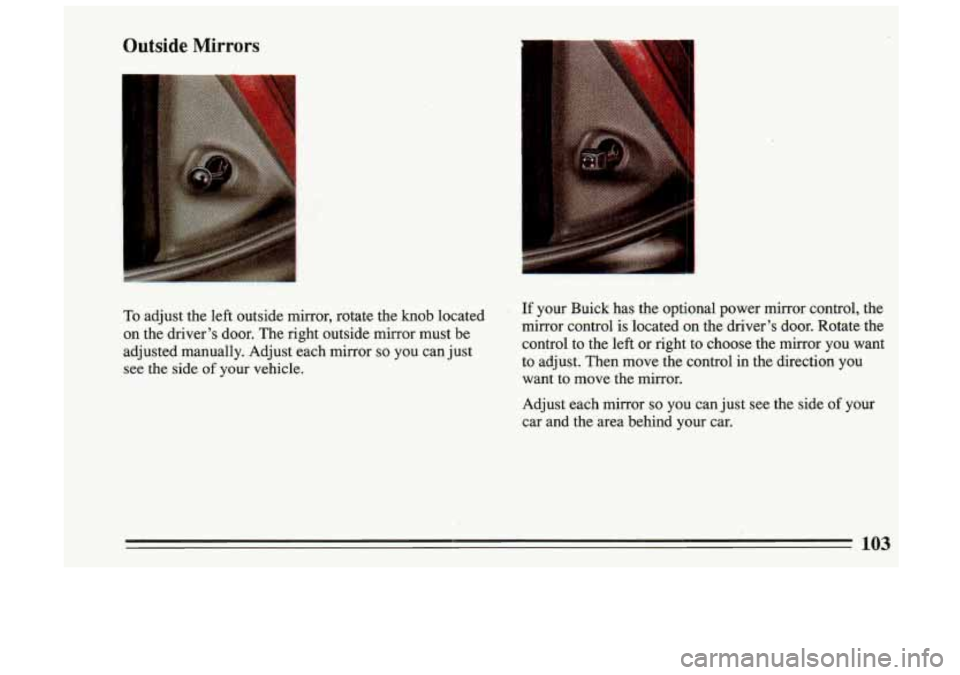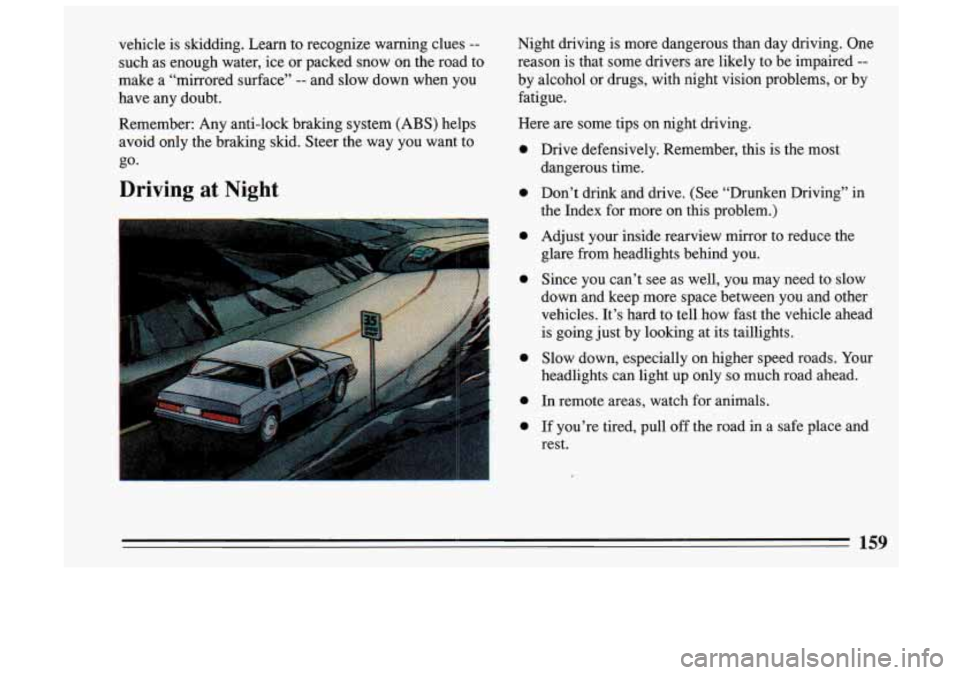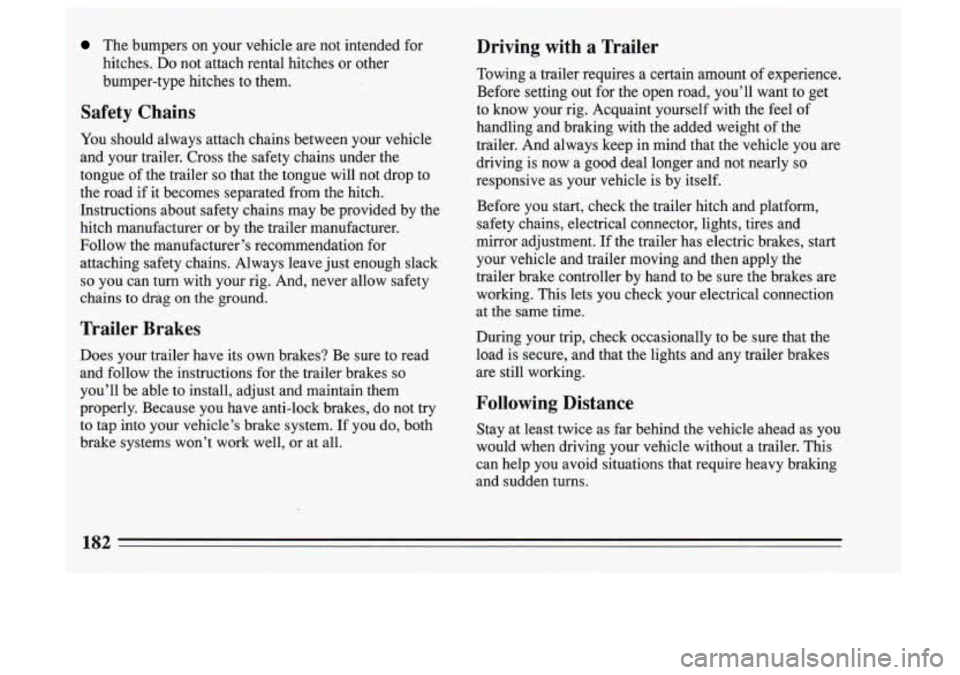1993 BUICK SKYLARK mirror
[x] Cancel search: mirrorPage 103 of 306

Courtesy Lights
When any door is opened, several lights go on. They
make it
easy for you to enter and leave the car. You also
can turn these lights on by rotating the interior light
control to
MAX.
The rear compartment lamp is also activated when the
doors are opened, the deck lid is opened
or when the
interior light control is rotated to
MAX.
Interior Lights Delay
On entry, the interior lights stay on, even after the door
is closed to give you time to find your keys
or controls.
The interior'lights go
off automatically when the
ignition is turned on, or after approximately
40 seconds.
This
40 second delay is disabled if the ignition has been
off less than
2 minutes. The interior lights will also go
on for
4 seconds if you pull on the door handle from the
inside trying to open a locked door.
Mirrors
Inside Mirror
When you are sitting.in a comfortable driving position,
adjust the mirror
so you can see clearly behind your car.
The day-night adjustment allows you to adjust the mirror
to avoid glare from the lights behind you.
102
Page 104 of 306

Outside Mirrors
I
To adjust the left outside mirror, rotate the knob located
on the driver’s door. The right outside mirror must be
adjusted manually. Adjust each mirror
so you can just
see the side
of your vehicle.
If your Buick has the optional power mirror control, the
mi.rror control is located on the driver’s door. Rotate the
control to the left or right to choose the mirror you want
to adjust. Then move the control in the direction you
want to move the mirror.
Adjust each mirror
so you can just see the side of your
car and the area behind your car.
Page 158 of 306

So here are some tips for passing:
0
0
0
0
“Drive ahead.” Look down the road, to the sides, and
to crossroads for situations that might affect your
passing patterns. If you have any doubt whatsoever
about making a successful pass, wait for a better
time.
Watch for traffic signs, pavement markings, and lines. If you can see a sign up ahead that might
indicate a turn or an intersection, delay your pass.
A broken center line usually indicates it’s all right to
pass (providing the road ahead is clear). Never cross
a solid line on your side of the lane or a double solid
line, even if the road seems empty of approaching
traffic.
If you suspect that the driver of the vehicle you want
to pass isn’t aware of your presence, tap the horn a
couple of times before passing.
Do not get too close to the vehicle you want to pass
while you’re awaiting an opportunity. For one thing,
following too closely reduces your area of vision,
especially if you’re following a larger vehicle. Also,
you won’t have adequate space if the vehicle ahead suddenly slows or stops. Keep back a reasonable
distance.
0 When it looks like a chance to pass is coming up,
start to accelerate but stay in the right lane and don’t
get too close. Time your move
so you will be
increasing speed as the time comes to move into the
other lane. If the way is clear to pass, you will have a
“running start” that more than makes up for the
distance you would lose by dropping back. And if
something happens to cause you to cancel your pass,
you need only slow down and drop back again and
wait for another opportunity.
If other cars are lined up to pass a slow vehicle, wait
your turn. But take care that someone isn’t trying to
pass you as you pull out to pass the slow vehicle.
Remember to glance over your shoulder and check
the blind spot.
Check your mirrors, glance over your shoulder, and start your left lane change signal before moving out
of the right lane to pass. When you are far enough
ahead of the passed ‘vehicle to see
its front in your
inside mirror, activate your right lane change signal
and move back into the right lane. (Remember that your right outside mirror is convex. The vehicle you
just passed may seem to be farther away from you
than it really is.)
157
Page 160 of 306

vehicle is skidding. Learn to recognize warning clues --
such as enough water, ice or packed snow on the road to
make a “mirrored surface”
-- and slow down when you
have any doubt.
Remember: Any anti-lock braking system (ABS) helps avoid only the braking skid. Steer the way you want to
go.
Driving at Night
Night driving is more dangerous than day driving. One
reason is that some drivers are likely to be impaired
--
by alcohol or drugs, with night vision problems, or by
fatigue.
Here are some tips on night driving.
0
0 0
0
0 Drive defensively. Remember, this is the most
dangerous time. Don’t drink and drive. (See “Drunken Driving” in
the Index for more
on this problem.)
Adjust your inside rearview mirror to reduce the glare from headlights behind you.
Since you can’t see as well, you may need to slow
down and keep more space between you and other vehicles. It’s hard to tell how fast the vehicle ahead
is going just by looking at its taillights.
Slow down, especially on higher speed roads.
Your
headlights can light up only’s0 much road ahead.
In remote areas, watch for animals.
If you’re tired, pull
off the road in a safe place and
rest.
Page 161 of 306

Avoid staring directly into the approaching lights. If
there is a line of opposing traffic, make occasional
glances over the line of headlights to make certain that
one of the vehicles isn’t starting to move into your lane.
Once you are past the bright lights, give your eyes time
to readjust before resuming speed.
High Beams
If the vehicle approaching you has its high beams on,
signal by flicking yours to high and then back to low
beam. This is the usual signal to lower the headlight
beams. If the other driver still doesn’t lower the beams,
resist the temptation to put your high beams on. This
only makes two half-blinded drivers.
On
a freeway, use your high beams only in remote areas
where you won’t impair approaching drivers. In some
places, like cities, using high beams is illegal.
I
Night Vision
No one can see as well at night as in the daytime. But as
we get older these differences increase. A 50-year-old
driver may require
at least twice as much light to see the
same thing at night as a 20-year-old.
What you do in the daytime can also affect your night
vision. For example,
if you spend the day @ bright
sunshine you are wise to wear sunglasses. ,Your eyes will
have less trouble adjusting to night.
But
if you’re driving, don’t wear sunglasses at night.
They may cut down on glare from headlights, but they
also make a lot of things invisible that should remain
visible
- such as parked cars, obstacles, pedestrians, or
even trains blocking railway crossings. You may want to
put on your sunglasses after
you have pulled into a
brightly-lighted service or refreshment area. Eyes
shielded from that glare may adjust more quickly to
darkness back on the road: But be sure to remove your
sunglasses before you leave the service area.
You can be temporarily blinded by approaching lights.
It can take a second or two, or even several seconds, for
your eyes to readjust to the dark. When you are faced
with severe glare (as from a driver who doesn’t lower
the high beams, or
a vehicle with misaimed headlights),
slow down a little.
..
When you follow another vehicle on a freeway or
highway, use low beams. True, most vehicles now have
day-night mirrors that enable the driver to reduce glare. But outside mirrors are not
of this type and. rh beams
from behind can bother the driver ahead.
160
Page 168 of 306

Entering the Freeway
At the entrance there is usually a ramp that leads to the
freeway. If you have a clear view of the freeway as you
drive along the entrance ramp, you should begin to
check traffic. Try to determine where
you expect to
blend with the flow. If traffic is light, you may have no
problem. But if it is heavy, find a gap as you move along
the entering lane and time your approach. Try to merge
into the gap at close to the prevailing speed. Switch on
your turn signal, check your rearview mirrors as you
move along, and glance over your shoulder as often as
necessary. Try to blend smoothly with the traffic flow.
Driving on the Freeway
Once you are on the freeway, adjust your speed to the
posted limit or to the prevailing rate
if it’s slower. Stay
in the right lane unless you want to pass.
If you are on a
two-lane freeway, treat the right lane as the slow lane
and the left lane as the passing lane.
If you are on a three-lane freeway, treat the right lane as
the slower-speed through lane, the middle lane as the
higher-speed through lane, and the left lane as the
passing lane.
Before changing lanes, check your rearview mirrors.
Then use your turn signal. Just before you leave the lane, glance quickly over your
shoulder to make sure there isn’t another vehicle in your
“blind” spot.
If you are moving from an outside to a center lane on a
freeway having more than two lanes, make sure another vehicle isn’t about to move into the same spot.
Look at
the vehicles two lanes over and watch for telltale signs:
turn signals flashing, an increase in speed, or moving
toward the edge of the lane. Be prepared
to delay your
move.
Once
you are moving on the freeway, make certain you
allow a reasonable following distance. Expect to move slightly slower at night.
Leaving the Freeway
When you want to leave the freeway, move to the proper
lane well in advance. Dashing across lanes at the last
minute is dangerous. If you miss your exit do not, under
any circumstances, stop and back up. Drive on to the
next exit.
At each exit point is a deceleration lane. Ideally it
should be long enough for you to enter it at freeway
speed (after signaling, of course) and then do your
braking before moving onto the exit ramp.
Unfortunately, not all deceleration lanes are long enough
-- some are too short for all the braking. Decide when to
167 2-
Page 170 of 306

0
0
Weather Forecasts: What’s the weather outlook
along your route? Should you delay your trip a short
time to avoid a major storm system?
Maps: Do you have up-to-date maps?
On the Road
Unless you are the only driver, it is good to share the
driving task with others. Limit turns behind the wheel to
about
100 miles (160 km) or two hours at a sitting.
Then, either change drivers or stop for some refreshment
like coffee, tea or soft drinks and some limbering up.
But do stop and move around. Eat lightly along the way.
Heavier meals tend to make some people sleepy.
On two-lane highways or undivided multilane highways
that do not have controlled access;you’ll want to watch
for some situations not usually found on freeways.
Examples are: stop signs and signals, shopping centers with direct access to the highway, no passing zones and
school zones, vehicles turning left and right
off the road,
pedestrians, cyclists, parked vehicles, and even animals.
Highway Hypnosis
Is there actually such a condition as “highway hypnosis”?
Or is it just plain falling asleep at the wheel? Call it
highway hypnosis, lack of awareness, or whatever.
I
There is something about an easy stretch of road with the
same scenery, along with the hum of the tires on the road,
the drone of the engine, and the rush of the wind against
the vehicle that can make you sleepy. Don’t let it happen
to you!
If it does, your vehicle can leave the road in
than a second, and you could crash and be injured.
What can you do about highway hypnosis? First, be
aware that it can happen.
Then here are some tips:
0
0
0
0
Make sure your vehicle is well ventilated, with a
comfortably cool interior.
Keep your eyes moving. Scan the road ahead and
to
the sides. Check your rearview mirrors frequently and your instruments from time to time.
This can help you
avoid a fixed stare.
Wear good sunglasses in bright light. Glare can cause
drowsiness. But don’t wear sunglasses at night. They will drastically reduce your overall vision at the very
time you need all the seeing power you have.
If you get sleepy, pull
off the road into a rest, service,
or parking area and take a nap, get some exercise, or
both. For safety, treat drowsiness on the highway as
an emergency.
As in any driving situation, keep pace with traffic and
allow adequate following distances.
169
Page 183 of 306

The bumpers on your vehicle are not intended for
hitches.
Do not attach rental hitches or other
bumper-type hitches to them.
Safety Chains
You should always attach chains between your vehicle
and. your trailer. Cross the safety chains under the
tongue of the trailer
so that the tongue will not drop to
the road if it becomes separated from the hitch.
Instructions about safety chains may be provided by the
hitch manufacturer or by the trailer manufacturer.
Follow the manufacturer’s recommendation for
attaching safety chains. Always leave just enough slack
so you can turn with your rig. And, never allow safety
chains to drag
on the ground.
Trailer Brakes
Does your trailer have its own brakes? Be sure to read
and follow the instructions for the trailer brakes
so
you’ll be able to install, adjust and maintain them
properly. Because you have anti-lock brakes, do not try
to tap into your vehicle’s brake system. ff you do, both
brake systems won’t work well, or at all.
Driving with a Trailer
Towing a trailer requires a certain amount of experience.
Before setting out for the open road, you’ll want to get
to know your rig. Acquaint yourself with the feel of
handling and braking with the added weight of the
trailer. And always keep in mind that the vehicle you are
driving is now a good deal longer and not.nearly
so
responsive as your vehicle is by itself.
Before you start, check the trailer hitch and platform,
safety chains, electrical connector, lights, tires and
mirror adjustment. If the trailer has electric brakes, start
your vehicle and trailer moving and then apply the
trailer brake controller by hand to be sure the brakes are working. This lets you check your electrical connection
at the same time.
During your trip, check occasionally to be sure that the
load
is secure, and that the lights and any trailer brakes
are still working.
Following Distance
Stay at least twice as far behind the vehicle ahead as you
would when driving your vehicle without a trailer. This
can help you avoid situations that require heavy braking
and sudden turns.